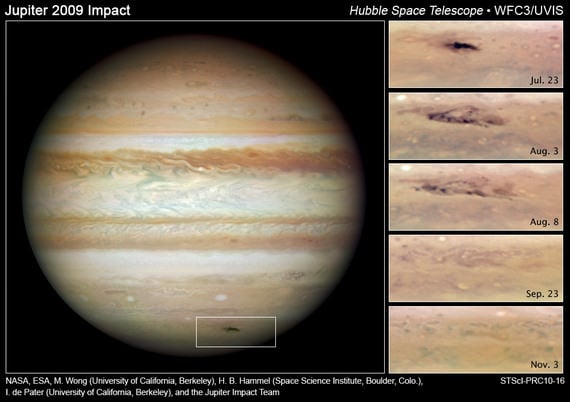[/caption]
Amateur astronomer Anthony Wesley from Canberra, Australia captured an image of Jupiter on July 19 showing a possible new impact site. Anthony's image shows a new dark spot in the South Polar Region of Jupiter, at approximately 216° longitude in System 2. It looks very similar to the impact marks made on Jupiter when comet Shoemaker-Levy 9 crashed into the gas giant in 1994. (But read the
Bad Astronomer's post
that the black spot could also be weather.)
UPDATE (7/20):
It has been confirmed this is an impact on Jupiter. Mike Salway shared the news Glenn Orton from JPL has imaged the Jupiter black spot with the NASA Infrared Telescope and he has confirmed it's an impact.
The list below shows the times (in UT) when the black spot will be visible again (generated in WinJupos by Hans-Joerg Mettig), and found on the
Mike Salway's Ice In Space website.
2009 Jul 19 06:09 ( 216°) 16:05 ( 216°) 2009 Jul 20 02:00 ( 216°) 11:56 ( 216°) 21:52 ( 216°) 2009 Jul 21 07:47 ( 216°) 17:43 ( 216°) 2009 Jul 22 03:38 ( 216°) 13:34 ( 216°) 23:30 ( 216°) 2009 Jul 23 09:25 ( 216°) 19:21 ( 216°) 2009 Jul 24 05:16 ( 216°) 15:12 ( 216°) 2009 Jul 25 01:08 ( 216°) 11:03 ( 216°) 20:59 ( 216°) 2009 Jul 26 06:54 ( 216°) 16:50 ( 216°) 2009 Jul 27 02:45 ( 216°) 12:41 ( 216°) 22:37 ( 216°) 2009 Jul 28 08:32 ( 216°) 18:28 ( 216°) 2009 Jul 29 04:23 ( 216°) 14:19 ( 216°)2009 Jul 30 00:15 ( 216°) 10:10 ( 216°) 20:06 ( 216°) 2009 Jul 31 06:01 ( 216°) 15:57 ( 216°)
If you get the opportunity to observe or image this potential new discovery, please do.
On his observing blog,
Anthony said he began observing Jupiter at approximately 11pm local time (1300UTC), using a 14.5" Newtonian telescope. "I'd noticed a dark spot rotating into view in Jupiter's south polar region and was starting to get curious," he wrote. "When first seen close to the limb (and in poor conditions) it was only a vaguely dark spot, I thought likely to be just a normal dark polar storm. However as it rotated further into view, and the conditions also improved, I suddenly realized that it wasn't just dark, it was black in all channels, meaning it was truly a black spot."
First he thought it might be a dark moon (like Callisto) or a moon shadow, but it was in the wrong place and the wrong size. "Also I'd noticed it was moving too slow to be a moon or shadow. As far as I could see it was rotating in sync with a nearby white oval storm that I was very familiar with - this could only mean that the back feature was at the cloud level and not a projected shadow from a moon. I started to get excited."
Hard-Hat tip to Mike Salway for alerting UT to the news.
 Universe Today
Universe Today
